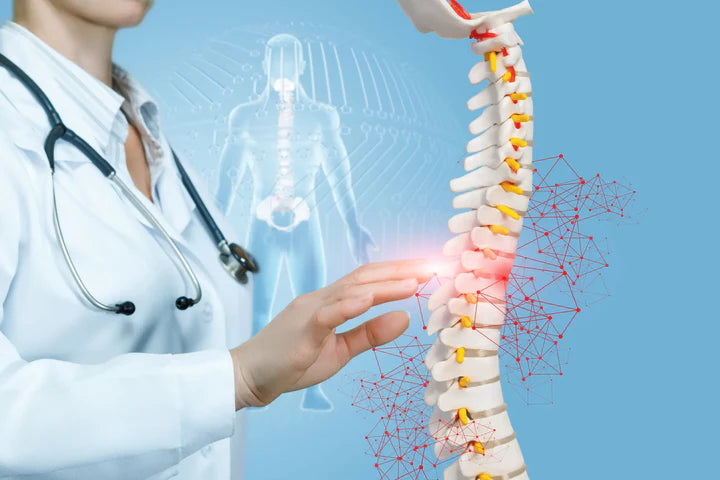Symptoms
Osteoporosis is a silent disease that does not cause dramatic symptoms. Most chronic pain that patients notice is due to pathological fractures. Pathologic fractures are fractures that occur without obvious force. Examples include vertebral fractures during sudden movement or tibial fractures during light sports. Patients are asymptomatic for years before such fractures are noticed. After the fractures, bone and muscle pain begin, with the back being most affected.
Fractures of the spine occur with sudden pain that usually does not spread and worsens when carrying heavy loads. After the acute pain, there is tenderness at the site of the vertebral fracture, and the pain lasts for months and sometimes does not go away. Due to vertebral fractures, the posture changes. The posture becomes kyphotic (hunched). In addition to the spine, the small bones of the hand and foot are also affected. Osteoporosis is often diagnosed when a foot bone is accidentally broken. The foot consists of 26 bones, most of which are very small and can break under stress.

Epidemiology
Osteoporosis is the most common metabolic bone disease and also the most common disease leading to fractures. Fractures cause enormous costs to the healthcare system, with nearly 9 million fractures occurring each year. About 200 million people worldwide suffer from osteoporosis, and one in three women over the age of 60 is affected by osteoporosis. Fractures most commonly occur in the spine and often cause no symptoms. 25% of postmenopausal women have at least one vertebral fracture. Fractures of the femoral neck, the lower part of the thumb bone (radius), and the lumbar spine are most common. The risk of fracture increases as bone density decreases. Osteoporosis is a disease of developed countries, and the highest incidence of osteoporosis is in Asia, North America, and Europe. Due to increased life expectancy, better medical care for the elderly, and a lifestyle that neglects physical activity and healthy eating, osteoporosis is considered a disease of the future.
Diagnosis
Osteoporosis is very often found incidentally when a bone fracture is diagnosed or during a systematic examination.

Densitometry – this test is the gold standard in the diagnosis of osteoporosis and is also the most accurate test for measuring bone density, i.e. bone mass. The method is non-invasive, requires no preparation, and is simple and quick. The examination takes only 5 minutes, and the radiation dose during the examination is negligible. Densitometry is recommended for people over 50 years of age who are treated long-term with corticosteroids, for men over 70 years of age and women over 65 years of age, for people who have noticed a loss of height of several centimeters, for women with amenorrhea (absence of menstruation) and others.
CT is used in the diagnosis of osteoporosis of the tibia (shin bone) and radius (thumb bone). The disadvantages of this method are the high price and the high dose of radiation that the patient receives during the examination.
Ultrasound – the advantage of ultrasound is the possibility of dynamic examination, the absence of radiation, wide availability… The disadvantage is the low sensitivity and the lack of data on bone density. Ultrasound is based on waves with a frequency of 200 to 1000 kHz and is used in the area of the thumb, fingers, tibia and calcaneus.
X-ray – X-rays of the bones are not used as a method of diagnosing osteoporosis due to insufficient accuracy. X-ray measurement is highly individualized, and the margin of error in assessing bone mass is as high as 50%. X-rays work well as a screening method in the general population, but osteoporosis is not detected on x-rays until about 30% of bone mass has been lost.





